An agreement to develop a 500,000-square-foot “urban outlet” retail center on the site of the soon-to-be-former Candlestick Park has been signed and the shopping center is slated to open in 2017, developed in partnership between Lennar, the neighborhood’s master developer, and retail developer Macerich, the developer of The Village at Corte Madera and Broadway Plaza in Walnut Creek.
According to the Chronicle, the pedestrian-friendly Candlestick Point project will feature “neighborhood retailers, restaurants, an African-diaspora-themed marketplace, movie theaters, a performance venue and hotel,” with underground parking and housing and entertainment above the stores, similar to Santana Row in San Jose.
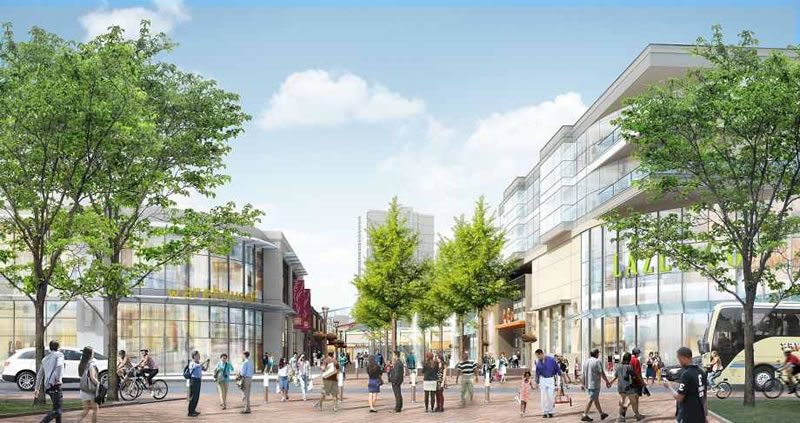
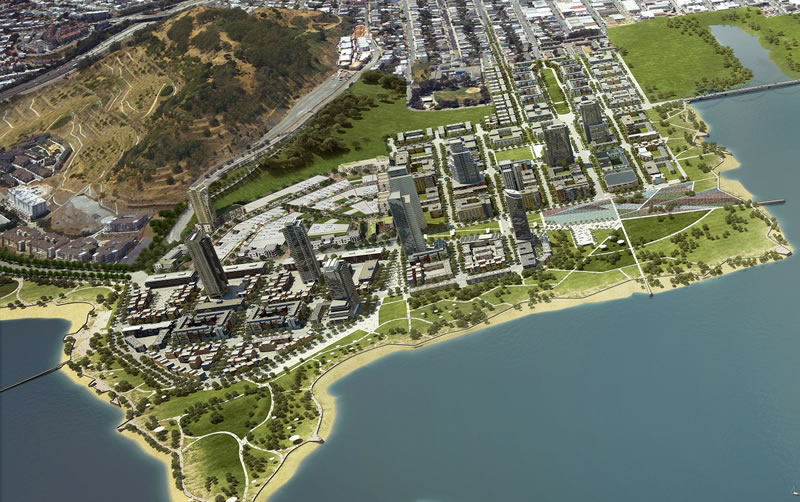
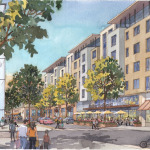
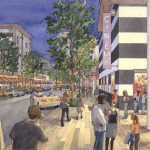
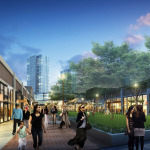
The problem with these mega developments is that the businesses, restaurants, shops, that are allowed to lease space here will all be very bland. Are chain laws in effect here?
I don’t get why you think these will be “bland”. Is it just that so called tolerant San Franciscans want every single retail outlet to be as weird and bizarre as, say, the pirate store on Valencia?
I guess because being weird and bizarre is “cool” and hip and trendy and desirable, and anything that cannot meet that criteria is just awful.
And bland.
Who cares if it is bland?; it is on Candlestick Point, hipsters will not be moving there any time soon. The fact is that outlet stores etc. are very popular with a large swath of the population. This seems like a fine way of addressing the retail needs/wants of those people. Those who want and can afford hip and cool can still go to Valencia Street or Hayes Valley.
2017 seems like wishful thinking.
Yeah, my fear is that this becomes too Santanarow-ish, too much suburbia-tying-to-be-urban. I hope planning doesn’t drop the ball on this, just because it’s BVHP- for once do your damn job in this area!
While I’m not in love with suburban style shopping malls, I do wonder — how else do you create a new neighborhood center in an area where one does not currently exist? There isn’t an existing retail corridor there to build up from…..
I agree…there is only so much you can do with entirely new construction.
I also wonder if they plan it so the cold winds off the bay get shielded as best as possible.
Also, if it’s an “outlet” theme, it’s gotta have chain stores- and lots of them.
yeah, it gets murderously cold out there.
Just have to create a dense street grid, and sell off parcels.
Exactly. That’s how most cities are built. Lot-by-lot. You also get the benefit of architectural diversity when parcels are sold off individually.
But most cities start small and build up; it is not like they started with skyscrapers in Manhattan. The goal of this approach is that one can immediately have dense retail supported by dense residential. That wouldn’t necessarily happen if you just sold lots and waited to see what happened. On the one hand the result seems “fake” to some because it is not as diverse and organic, on the other hand, it is probably more functional.
that is EXACTLY what SF should do…And add a raffle element to it so it’s not all big business and contractors buying everything…
It is a little we can’t seem to do it this way any more. But I guess the profits are quicker, the fees and exactions easier to swallow, and the safety for banks and other investors funding the thing.
More seriously, who is going to pay to install this “dense street grid” and all the infrastructure and amenities? I doubt the water lines, sewers, parks, etc are in place? These days, we demand a somewhat “finished” level of infrastructure and amenities even before a single homeowner or tenant has moved into the neighborhood.
You extend the street grid and keep the zoning of the nearby streets. Then it becomes an integrated part of the city. This thing is designed to break the pattern, not become part of it. The mall will be dead in a few years.
Even if chain laws weren’t in effect, I doubt small mom and pop stores could afford to pay the kinds of rents they will likely demand. This is no different than a suburban mall with a few condos built on top of it. If the plan looks anything like the sketch, it will will contain too few commercial spaces for it to be a true “urban outlet.”
I wish developers would build in narrower commercial units with a small street footprint, but squeeze more such units into the street. This would appeal to smaller restaurants/shops which can’t afford the premium spaces. This is my biggest problem with much of the financial district. It basically means few options for smaller sandwich shops, coffee shops, or other restaurants, and in the end that results in fewer options for lunch.
I can’t believe they’re still giving lip service to the “African-diaspora themed marketplace”. This idea was (cynically) included in the HPNS plan as a sop to a suspicious community. Now it seems to have popped up within the proposed outlet mall at Candlestick? Bizarre. No one knows what this actually is, and I expect it will end up being a couple of culturally appropriate vendors in the food court.
Some Sudanese or Ethiopian food would be cool….give em a sf-gov subsidy on the rent and viola.
A subsidy on a viola? Are they going to be serenading me as I eat?
Hey, at least live music is better than violins on television…
They’ll have a fried chicken joint and call it a wrap. That’s pretty much where the Fillmore “Jazz District” is evolving.
It would be informative to read the many comments in sfgate in reaction to this development. Commentary on wind and chill factors that many cite as well as inaccesability from 101 and Bay Area in general, high crime rate in surrounding areas, plenty of alternative shopping areas closeby, (Serramonte, Tanforan, Stonestown, Hillsdale) why would anyone go to a windy shopping mall that is difficult to access. One of the commenters suggested locating city offices and bus yards, maintenance bases out there, that would allow the city to sell off strategic properties for development (such as the Fisherman’s Wharf bus yard)….but given SF government lack of imagination and planning, this idea will probably go nowhere.
“inaccesability from 101”
What?
should have edited, yes it does have access to/from US 101, but I was meaning the exits and ramps into the area are not the best and were cited as one of the reasons not to build a stadium there.
For the stadium, the access is bad because you have so many people trying to get in and out and the exact same times. For a shopping mall, the exits are probably adequate to handle a steady stream of cars.
As of now, the “most liked” comment on SFGate is: “I look forward to not going there.”
From talking to SFMTA staff, it’ll be a hard fought battle to sell the Wharf yard. It’ll be needed for Phase 3 central subway at a minimum, and ideally a storage barn for classic street cars.
As for the Candlestick lot, the best use right now would be for a SFMTA driver training facility, as they have been kicked off the piers and only have a transient training area now. Whatever happens with CandleStick, the T and CalTrain must be brought into it, otherwise it is just another Emeryville-style mall. I can’t imagine this plan is going to pass planning muster, it’s awful and nothing like plans in the rest of the city.
It already takes about 37 years to go from Embarcadero to the end of the T line. I can only imagine how long it will take to get to the Candlestick Outlet Mall, stopping at the lights at every corner.
The T had a chance to make the Dogpatch and Bayview first-class neighborhoods, but not without grade separation of some kind. They tore up the street for ten years anyway; I don’t understand why they didn’t just put it in a trench, with the cross streets passing over it. Or God forbid, an elevated train, but the local NIMBYs would never allow that “eyesore.”
seems a bit bland but I’m imagining this will be more like bay st in emeryville. There’s even an African store there!
“Bland” is a huge step up from the sort of adjectives that currently describe SF’s southeast corner.
I’m thinking it will be like Marin City’s mall. Vacant within five years.
Does anyone know if there are there any sort of inclusionary terms that “encourage” developers to add more affordable commercial space… similar to 12% BMR ordinance for housing? Seems like a no-brainer to try to intermix larger businesses with more local/independent ones.
Outlet centers are usually conceived of as a “destination” but getting to Candlestick Point will remain as difficult as ever for the San Franciscan who plays the game as our politicians want and does not own a car.
If only someone had invented a bigger sort of car that a lot of different people could get on to get to the same place. Like, imagine if it could even use the same roads that regular cars drive on. Oh well, I guess that’s just a pipe dream.
^ 🙂 Imagine!
Looks exactly like Emeryville. Couple big chains, some new condos and surrounded by an undesirable neighborhood.
And what exactly is wrong with Emeryville?
Among other things, a road plan that would have been better if designed by a chimp with crayons.
ROFLOL. I especially love how they have bicycling infrastructure that just…stops…in a middle of a sea of four and six lane roads freeway ramps, and shopping center parking lots!
Nothing. It serves its function within the greater Bay Area well. If there’s one thing wrong with it, it would be cool if it had a BART stop so people could go to IKEA without a car, especially when the bridge is jammed up. We need places like Emeryville, with commercial space, office space, lab space, industrial space and affordable nice living space directly between two major cities (and Berkeley.)
I know people in third world countries schlepp things around on their backs, but who goes to Ikea without a large car or van to carry the flat boxes? Do you really see people carrying the boxed shelving systems and beds onto BART?
I suspect they’d have the boxes delivered, as we do. (Although I’d be willing to try those giant cargo trikes that Ikea rents to its European customers, assuming Emeryville built protected lanes for them.)
Hopefully there will be neighborhood serving stores– a supermarket, cleaners, etc– and interesting restaurants/cafes, so that people in the new housing can shop locally. This could be a big selling point for development in the area, which is isolated from the services people expect living in a city.
That last thought is certainly interesting and apropos generally to the notion that people just have to get the tired old stereotypes out of their minds about “The Stick” centered upon trying to play baseball games in an SF summer beginning at 7:00 PM.
I’m not sure how I feel about including a destination retail center but am very excited about what a spectacular self-contained stand alone alone neighborhood this can be. It’s a spectacular location in itself and needs only upgraded transit connections to be fully integrated with the City’s employment center. Their model should be Coal Harbor in Vancouver (note the numerous high-rise residences in the plan) although it enjoys a closer in location there. Still, I could see “Candlestick Cove” becoming a very popular enclave for the younger Tech crowd with its very convenient access to the Peninsula yet SF address.
I’m sure the “open space” advocates will howl at the thought, but the expansive and varying waterside areas should be exploited for dining and entertainment venues as a draw to keep people in the hood. Again, look to Coal Harbor.
I’m cool if this is >75% chain. This will mostly get commuters during the week and possibly bargain shoppers on weekends. Chains are appropriate here. It will be super convenient for the thousands of Silicon Valley commuters coming back into SF after 5
Outlet malls are generally more Asian-diaspora-themed, if you ask me.
It’s posts like this that make me wish Socketsite had a “like” button.
Just for the username alone!
We live in the area and although I don’t care for Santana Row style places it’s much better than the other corporate retail options and it appears that this will be much denser and urban than other projects. I assume it will be mostly chain retailers but this is a good spot to have them where they aren’t displacing independents, SF can get the tax revenue and the location is convenient to 101 with planned connections to public trans. In the SE sections of SF there is already 3rd street in Bayview, San Bruno Ave in Portola and Leland in Vis Valley which are all great spots for local businesses to grow with the rapidly changing demographics of these neighborhoods, San Bruno Ave and Third are already seeing the first influxes of hip independents open up.
Yeah, Satanic Row isn’t the end-all with its fake urbanism. But still a vast improvement over what was in that site before which was a 1 story sprawling Town and Country shopping center surrounded by surface parking. It was sleepy and nearly dead a decade before SR broke ground. Now it is lively. Fake and commercial but at least lively.
Sunnyvale tore up its Town and Country center too and it is now being replaced with apartments over retail too. It is too early to tell but the results should be good.
I don’t get your derisive comments calling it “Satanic” row, and “fake” urbanism. All architecture is “fake” in a way, created by humans to engender a mood or feeling or spirit.
Even modernism can be fake. Even the most uber-cool new building can be seen as fake. So my point being, why even use the term “fake” when you really just don’t like it. Your comment and other here pretty much sum up the intolerance of so called tolerant San Franciscans for anything other than some old/funky/weird storefront on Valencia or Haight.
Not a point worth making and misplaced as well. SR is FAKE as hell inasmuch as it tries to insert a bit of Italia in the heart of San Jose’s interminable sameness.
Imagine how fake the Victorians must have felt to the Mexican settlers. Or the Missions to the Ohlone. Or the Teepees to the cavemen. So what’s your point?
Yea, it’s a valid point in the discussion. I guess you’re also bothered by anything you deem to be fake, rather than “authentic”. Perhaps you’d be happier if the architecture were all replicated “Victorian”? Would it be less fake to you.
I welcome this development in the Southern reaches of SF. It will spur growth and much needed development.
Victorian is the epitome of “fake” in SF, considering Queen Victoria never actually ruled here. So I guess after a certain amount of time all fakeness can become authentic.
@Futurist, I agree and would ask people to read about the early architects in Northern California who all had a difficult time trying to decide which pre-existing architectural vocabulary was appropriate for this area. Julia Morgan was designing wood shingle arts and crafts structures at the same time as faux gothic cottages and even a hilltop mansion based on a church in Spain, all of which could be called “fake”, but all of which are beautiful buildings. Although I am a fan of Ernest Coxhead, his designs were inspired by structures in the Cotswolds, and (Charles) Warren Callister was designing hybrids somewhere between Greene and Greene and Japonesque structures. yet all of his designs are beautiful and appropriate for the Bay Area as well.
My definition of “fake” in San Francisco is when someone takes a historic home and strips the interior bare and creates yet another faux Dwell interior. If you want a modern home (which is just as much as style as craftsman, Victorian, gothic or Spanish), why not hire an architect to build you a modern both on the interior AND exterior.
But to meet the demand that might require tearing down many of the real homes you prefer? Or are you saying that those who prefer modern styles in their interiors must be banished to the suburbs, or can only live in a modern high rise?
How pure do the historicist interiors have to be? Is there a middle ground where some remodeling is permitted? Are modern utilities permissable? What if the building is a maze of tiny, dark rooms and the remodel is superior in terms of functionality and safety?
I just don’t think it is as pure a question as you believe.
Great comments and I agree and have enormous respect for those architects, including Maybeck and even late modernists like Esherick.
I really think the comments made by those who abhor “fake” historicist exteriors really are just acting like typical arrogant San Franciscans who seem to think that ONLY The City is authentic; The stores must be old, run down storefronts with “character” they must be a pirate store and a store selling retro 50s record players. And, of course, it must be on Valencia.
They abhor suburbia; they abhor San Jose; they abhor Santana Row because it is new, it’s recently created and it’s not what they want. It’s about intolerant San Franciscans at their best.
Maybe if they copied the 1960s auto body shop industrial vibe in parts of the Bayview? Go for an authetnic Brazilian Favella look, with no building or health codes or paved streets? THAT would be authentic as hell! Maybe we could even provide a camping space for the zombies to relocated from Market Street!!!!
No need to relocate zombies from elsewhere. Just bring back the historic radioactive contamination and create new “authentic Hunters Point” zombies.
Futurist – You ought to visit Santana Row before jumping to conclusions. It is indeed covered with fake facades and those in turn covered with fake advertisements. At first glance it gives an urban feel but if you look at the street and sidewalk plan from an urbanist perspective it doesn’t really mesh with the fabric of the neighborhood.
Then you claim that everything is fake. That’s malarkey. The retail/residential development proposed across from the new Niners stadium isn’t fake. It is designed to look like a product of the 2010s. And so is this development at Candlestick. So they’ve got the appearance covered. Hopefully those projects will also enhance their encircling neighborhoods.
These sorts of 4-6 story residential over retail developments are an improvement. They bring density and vitality to former dead zones. They could be greater by letting go of their shopping mall closed-community aspects and become part of a city.
Been there several times. It’s fine, easy to park, variety of shops. No complaints.
And I still arrived back in San Francisco without looking like a “suburbanite”.
Just watch all the elitist San Franciscans complain about how much this will be like Bay Street or, god forbid, Santana Row – while at the same time bitching and moaning about the decreasing diversity of SF. Been to Emeryville or San Jose lately? The diversity of those places puts Valencia Street to shame.
Ha I’m not sure that’s accurate.
Populations served? Hell yes it is accurate.
Exactly. It’s the elitist San Franciscans who think the universe revolves around out little city by the bay.
Living in a town renown for charlatans and drag queens, cold summers and liquid land, that somehow convinced a nation to eat fortune cookies and rice a roni, that carpeted sand dunes with golf courses, and overlaid bay mud with mansions, fakery just might be the principal indigenous artform.
And of such mastery, so completely ingrained, as to be above comment and beneath contempt; for what is there to say: of course the plans of the planning department are overcome by planned events, of course the crime lab was run by criminals, of course a mayor who would never run will be reelected….
No, forget about it Jake, its San Francisco.
If all the faux were to fall away, not sure the place wouldn’t collapse just to see itself bare without full drag in situ. We need our little asphalt and concrete botox injections to shore up our crackle pavement and foundations against the creeping seismic tides. We’ll build all the boxes the alphabet of Props will prop up, the funders find fun, and the landslides abide.
I’m not so much bothered by the fakes and the faux; it’s the facsimiles that dull and deaden, in rows and rings of rigid sameness and is the danger in these ersatz towns within the city. When I hear the phrase master plan, I reach for my Laotze.
I’d rather an exquisite corpse infested with fakes.
How’d your head feel this morning?
Dandy, thanks for asking, though would have preferred the little one hadn’t waken me at 4 AM. Strong coffee and a laughing child is my usual pre-dawn tonic. And the dawn was a nice blue rinse, much better than the foggy dawns we’d been having.
Always nice to express my thoughts in a natural language as above after spending hours debuggin someone else’s atrocious software. Kind of a right/left brain balance.
And Sorkin’s old metaphor of cities evolving akin to the Surrealist game of the “exquisite corpse” has long been a favorite. Nothing fake about it, nosiree.
Why is the idea of an “outlet” mall such a draw? It used to be that the “outlets” were required by the vendors to be a certain distance from the “real” store. Now, however, Nordstrom Rack has two locations in the City – with one just across the street from the Nordstrom on Market. I suspect that in the next few years, other “outlet” stores will be located in the City itself. In addition, the magic is beginning to fade from the idea of an “outlet.” Many of these stores create their own line of less expensive merchandise. The clothes are cheaper because they are more cheaply made. Not the bargains that people might imagine.
e-commerce happened, that’s what. Outlet malls nowadays compete with online bargain shopping, not Union Square shopping.
I would imagine that more and more basic shopping will be on-line anyway. For the nabobs, there will always be the elite shopping themed experiences. And, of course, there will still be flea markets and Barter Towns for the rest of us. (Because even in e commerce world one sometimes wants to see the used goods!)
UPDATE: A Peek into the Future Look and Feel of Candlestick Point